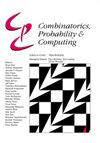Statistical Study of Relationship between Structural Properties and Mesomorphic Properties of Some Ester Linkage Mesomorphic Compounds
IF 0.8
4区 数学
Q3 COMPUTER SCIENCE, THEORY & METHODS
引用次数: 0
Abstract
A statistical study between ‘Mesophase Lower Transition Temperatures’ (MLTTs) and their structural properties is carried out to understand the effect of structural behaviour on mesomorphic property. To establish a “Quantitative Structure and Property Relationship (QSPR) model” a set of randomly selected thirty-nine mesomorphic compounds is constructed. The backward stepwise regression analysis method is used to find out the good correlation between the “Mesophase Lower Transition Temperatures (MLTTs)” data set and “physical descriptors” like AMR, bpol, ASP-0, DELS, SdssC, etc. Physical descriptors are selected based on their good r2 -values and p-values with respective MLTTs. The derived QSPR equation shows a good correlation between structural properties and mesomorphic properties of compounds. Validation of the derived QSPR equation is carried out on the test series of eight compounds. The MLTTs of these compounds are predicted through the statistically derived QSPR equation and then compared with experimentally measured MLTTs. The average percentage error observed between predicted MLTTs and experimentally measured MLTTs is observed 10.95 % for all the thirty-nine compounds of the trial set, and 10.64% for 8 compounds of the test series respectively. A low average percentage error suggests a reasonably acceptable degree of accuracy of the generated QSPR model to predict MLTTs of the compounds having a similar type of structure.In the present study not only MLTTs are predicted, but an effort also made to predict “Latent Transition Temperatures” (LTTs) of some non-mesomorphic compounds from derived QSPR equation. This computational study gives a sight to develop new QSPR models for the different-different type of liquid crystals homologous series, through which various types of mesomorphic properties, like mesomorphic thermal stability, mesomorphic upper transition temperature, mesophase length, phase behaviour, etc. can study and predict.某些酯链亚构化合物结构性质与亚构性质关系的统计研究
为了了解结构行为对介态性能的影响,对“中相低转变温度”(MLTTs)及其结构性能进行了统计研究。为了建立一个“定量结构与性质关系(QSPR)模型”,我们随机选择了39个介形化合物。采用后向逐步回归分析方法,发现“中间相较低转变温度(MLTTs)”数据集与AMR、bpol、ASP-0、DELS、SdssC等“物理描述符”具有良好的相关性。物理描述符是根据其良好的r2值和p值与各自的mltt来选择的。推导出的QSPR方程显示了化合物的结构性质与介形性质之间良好的相关性。在8个化合物的测试系列上验证了所建立的QSPR方程。通过统计导出的QSPR方程预测了这些化合物的mltt,并与实验测量的mltt进行了比较。在试验集的所有39种化合物中,预测的mltt与实验测量的mltt之间的平均百分比误差分别为10.95%和10.64%。较低的平均百分比误差表明,所生成的qspr模型在预测具有相似结构类型的化合物的mltt时具有合理可接受的精度。在本研究中,我们不仅预测了mlttr,而且还从推导的QSPR方程中预测了一些非介形化合物的“潜在转变温度”(LTTs)。本计算研究为建立不同类型-不同类型液晶同源系列的新的QSPR模型提供了前景,通过该模型可以研究和预测各种类型的亚晶性质,如亚晶热稳定性、亚晶上转变温度、中间相长度、相行为等。
本文章由计算机程序翻译,如有差异,请以英文原文为准。
求助全文
约1分钟内获得全文
求助全文
来源期刊

Combinatorics, Probability & Computing
数学-计算机:理论方法
CiteScore
2.40
自引率
11.10%
发文量
33
审稿时长
6-12 weeks
期刊介绍:
Published bimonthly, Combinatorics, Probability & Computing is devoted to the three areas of combinatorics, probability theory and theoretical computer science. Topics covered include classical and algebraic graph theory, extremal set theory, matroid theory, probabilistic methods and random combinatorial structures; combinatorial probability and limit theorems for random combinatorial structures; the theory of algorithms (including complexity theory), randomised algorithms, probabilistic analysis of algorithms, computational learning theory and optimisation.
 求助内容:
求助内容: 应助结果提醒方式:
应助结果提醒方式:


